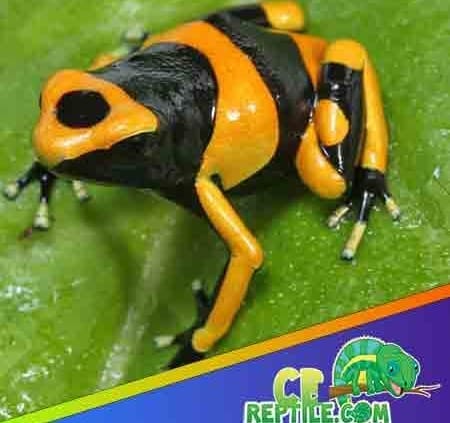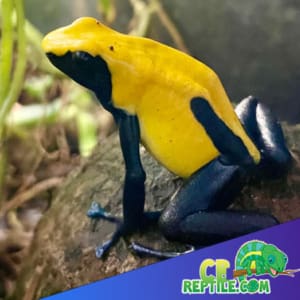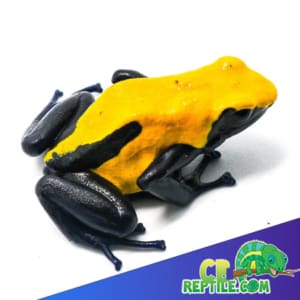
Poison Dart Frog size: What to Expect & How to Support Healthy Growth

Poison dart frogs are small, bold, and incredibly charismatic. Understanding how large they get at maturity—and which husbandry choices influence growth—helps you plan the right enclosure, diet, and environmental controls from the start. Below you’ll find typical adult sizes by group, the factors that affect final size, and practical guidance on humidity, temperature, UVB, fogger use, diet, and habitat design.
Adult Size at a Glance
Ranitomeya and similar “thumbnail” frogs typically mature around 0.7–1.1 inches (18–28 mm) snout-to-vent. Despite their tiny size, they are active and visible in secure, plant-dense setups.
Many Dendrobates (e.g., auratus, leucomelas, tinctorius) mature between 1.4–2.5 inches (35–64 mm). The larger morphs of D. tinctorius often sit at the top of that range.
- Small body = tight environmental tolerances
- Prey must be sized appropriately and offered frequently
- Dense foliage and leaf litter increase confidence and visibility
What Determines Final Size?
- Genetics & species: Species set the ceiling; morph and lineage can nudge size within the expected range.
- Sexual dimorphism: In some species, females are slightly broader; males may be a touch smaller but more call-active.
- Nutrition: Consistent access to gut-loaded micro-prey with disciplined calcium/vitamin rotation supports steady growth without obesity.
- Climate stability: Proper humidity and moderate temperatures drive appetite and digestion; swings suppress feeding and slow growth.
- Stress load: Visual barriers, minimal handling, and fresh air exchange reduce stress and help frogs remain bold and active.
Growth Timeline & Measuring
From metamorph to sub-adult, growth is fastest during the first 6–12 months. Juveniles often reach near-adult size by 10–14 months depending on species and diet. Measure length (snout-to-vent) using a transparent container placed briefly on a ruler; avoid frequent handling. Track body condition visually: smooth, rounded flanks, bright eyes, and consistent activity are better indicators than weight alone for such small amphibians.

Humidity & Temperature: Small Bodies, Tight Windows
Because dart frogs are tiny, they dehydrate quickly and overheat easily. Aim for daytime temperatures around 72–78°F (22–26°C) with a mild nighttime dip. Keep relative humidity 70–100% with gentle daily cycling—slightly drier after lights on, wetter later in the day. Monitor with a digital probe thermometer and a reliable hygrometer at mid-tank height; log highs/lows so you can tweak misting and ventilation proactively.
UVB: A Gentle Gradient Helps
Although these frogs inhabit the shaded understory, controlled access to low-level UVB supports natural vitamin D3 synthesis and skeletal health. Mount a gentle UVB tube across the screen lid and create shade pockets with broad leaves and cork flats so frogs can self-select exposure. Pair UVB with a plant-friendly LED; set a consistent 10–12 hour photoperiod on timers to stabilize rhythms.
Using a Fogger Without Overdoing It
A cool-mist ultrasonic fogger can stabilize humidity and add “cloud forest” ambiance. Run short cycles (10–20 minutes) on a timer or humidistat so you maintain moisture without saturating the enclosure. Direct mist to drift across foliage rather than blast a resting spot. Always use RO or distilled water to prevent mineral deposits and clean the reservoir/tubing regularly to avoid biofilm.
Habitat Recipe That Fits Their Size
A bioactive vivarium helps tiny frogs feel secure and visible. Build from the bottom up: a drainage layer (LECA or false bottom) beneath a mesh barrier; a moisture-retentive substrate (ABG-style blends are popular); and generous leaf litter. Seed with springtails and dwarf isopods to recycle waste and provide incidental snacks. Hardscape with cork flats, branches, and seed pods to create micro-hides and perches. Plant densely with pothos, philodendron, peperomia, ferns, and bromeliads—living foliage buffers humidity and encourages natural foraging.
Enclosure Sizing & Layout
- Footprint: A front-opening 18×18×18″ works well for a pair or small group of many species; larger volumes stabilize climate even better.
- Ventilation: Tight lid with cross-venting maintains humidity while keeping air fresh and oxygenated.
- Zones: Create wetter pockets under dense foliage and slightly drier, ventilated areas up high so frogs can self-regulate.
Diet & Supplementation for Small Frogs
Adult dart frogs may be petite, but they thrive on frequent, small meals. Offer what they’ll finish in 15–30 minutes, 4–6 days per week. Rotate Drosophila melanogaster and Drosophila hydei fruit flies, springtails, pinhead/micro crickets, and occasional tiny roach nymphs. Gut-load feeders 24 hours prior with leafy greens and a quality dry gut-load. Dust most feedings with calcium and rotate a multivitamin 1–2× weekly. If you provide UVB, a D3-free calcium can be used more often with periodic D3; without UVB, include D3 more regularly.
Daily & Weekly Care Practices
- Glance at temp/humidity probes and observe behavior
- Short mist/fog cycles as needed—avoid constant saturation
- Feed small portions; remove excess prey promptly
- Refresh bromeliad cups and water points regularly
- Log highs/lows and adjust timers seasonally
- Prune plants for airflow; rinse supplement dust off leaves
- Clean fogger reservoir/tubing; top off with RO/distilled
- Boost springtail cultures and refresh leaf litter
Common Mistakes That Impact Growth
- Heat spikes into the 80s°F that suppress appetite and dehydrate small bodies
- Running a fogger continuously without ventilation, leading to stagnant conditions
- Under-supplementing calcium/vitamins or offering prey that’s too large
- Using untreated hard tap water for misting/fogging (mineral residue and irritants)
- Sparse planting and few hides, which increases stress and reduces visible activity
poison dart frog for sale
and build your display around healthy, captive-bred frogs from a trusted team.
Final word: fully mature poison dart frogs are small—generally 0.7–2.5 inches depending on species—but their care is anything but “mini.” Hold temperatures in the mid-70s°F, keep humidity high yet fresh, provide a gentle UVB gradient, use foggers in short cycles, and feed a varied, gut-loaded micro-prey diet with smart supplementation. Layer these details into a dense, bioactive habitat and your adult frogs will reward you with color, confidence, and long, healthy lives.
